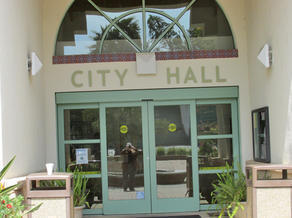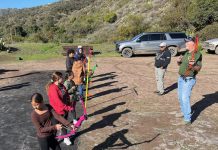The City Council had a second discussion about sidewalk vending permits at the Oct. 1 meeting.
Sidewalk vendor Daniel Felts and the council reached an informal agreement on two additional locations for vendors. Felts also proposed a streamlined, online process for permit applications. He also proposed increasing the number of permits from the current cap of six. That proposal received no support.
The council took no formal action. The city attorney will review the city ordinance and the map. The issue might return to the council at a future date.
The presentation and discussion of the subject took a little over half an hour.
Discussion
Community Services Manager David Hart gave the presentation for the Sidewalk Vending Update
He said he and Chief Alegria walked all over Crescent Avenue to evaluate the possibility of expanding street vending there.
Hart said long term viability of some the spaces they found spaces might be limited because of planned changes to the Elbow.
According to City Manager David Maistros, said there would still be room near the photo booth.
Vendor Daniel Felts said he sent the council a presentation with 12 different locations that he walked.
He added an area where an extra cart might be.
He said his presentation went over the benefits of sidewalk vending.
He argued that sidewalk vending supported business opportunities and promoted cultural diversity. He said his presentation went over what constituted a legitimate health and safety concern and the regulatory powers of local authority. The third section was the 12 locations Felts proposed.
Felts, who has a sidewalk vending permit, previously asked for expansion of the program which led to the council discussing the issue in September. (See “Avalon discusses street vendors,” at thecatalinaislander.com.) At the time, Felts argued the spots identified by the city were not economically viable.
Avalon emergency service officials have expressed concerns about access to Crescent Avenue. Felts argued that state law only allowed cities to regulate parks.
On Oct. 1, Felts went through his list of 12 locations which included a space next to Old Ben Park. He also identified the photo booth. Location six was where the former location for the stand-up paddle boards were located.
He said an area next to the steamer trunk would be a good location.
He cited a spot in front of the Pavilion Hotel.
He urged the council to look at the 12 spots he had identified.
He requested specific measurements for a cart in the city’s regulations.
Councilmember Mary Schickling asked him what size he used for the rectangle representing the cart.
“I did that as a visual estimation,” Felts said.
“Some of these look like you’d have to have a pretty small cart,” Schickling said.
Marshall said that space doesn’t represent the actual size of his cart.
Felts said no it did not.
Schickling said his cart is probably bigger than any of the rectangles in Felts’ presentation.
Councilmember Michael Ponce said that the first four spaces Felts had identified would take space from public access. He apparently referred to green areas.
Felts said he understood. Felts said street vendors were so heavily regulated that one of the only places they could set up were in city parks.
“But then you have to take into account our location; what we are,” Ponce said.
“These city parks are small,” Ponce said. “City parks on the mainland are going to be bigger.”
Ponce said he understood what Felts was saying, but Avalon did not have the space.
Schickling said she agreed with the spaces.
“Sometimes I’m just jostling to get through,” she said. She described the area near Old Ben Park as a “super busy” area.
Felts said sometimes the cruise ships have a long line of passengers standing out there for hours without refreshments.
Felts also agreed that the rectangle in his presentation (which was not shown on TV) was not representative of the space.
“If we could go and measure those locations, we’d have more information to make a better determination,” Felts said.
Schickling asked if he liked the spots that Hart pointed out.
Felts said two of Hart’s spots were on his list.
Council Member Yesenia De La Rosa argued that the sixth spot, next to an ATM, led to Front Street (a local nickname for Crescent Avenue) and the Mole. She described it as perfect.
Marshall was not happy with a spot in front of a planter.
Felts argued that if that space was allowed in once instance it should be allowed in another.
De La Rosa argued that the time of day made a difference.
Felts suggested a stipulation that vendors can only operate in that spot from 5 p.m.
Marshall opposed putting a vendor spot next to the stage.
Felts said there was room for a vendor to operate and still have 10 feet of space to have access to the box at that location.
“Again, if we measured everything, we would have more information,” Felts said.
DLR said she would be more comfortable if the area were measured.
Schickling opposed a vending spot at the foot of the pier.
De La Rosa said she wasn’t comfortable with daytime vendor use of the beach entrances.
Schickling said she didn’t have a problem with location 10, the old taxi stand. However, she wanted measurements for the space.
“But that’s not a park,” Marshall said.
Schickling didn’t like the spot in front of the planter, number eight.
“It feels like encroachment,” Schickling said.
Maistros said the current code says you can’t place carts in front of benches.
Maistros said spaces and five and six had been identified by Hart and Fire Chief Michael Alegria.
According to Maistros, in addition to space the issues are health, safety, and welfare. He included maintaining views as part of welfare.
Felts said he understood what Maistros was saying, but his cart had a simple umbrella. He said it wouldn’t be out of place. He said the term welfare did not mean visual aesthetics.
City Attorney Scott Campbell said the city disagreed. He said welfare was not defined in the state legislation. “It’s broader than just health and safety,” Campbell said.
He argued that would make the word “welfare” superfluous. “It’s there for a reason,” Campbell said.
Felts conceded that there was concern that a cart would take away from the visual aesthetic, but said he didn’t agree.
“I’m pretty sure SB 946 was passed to limit certain instances where local authorities were maybe imposing restrictions that were making it a little more difficult than they should,” Felts said.
Fire Chief Alegria spoke next.
He identified several of the proposed vending locations as staging areas. “We don’t have just one fire engine that goes,” he said.
“We have a patrol [vehicle], we have an ambulance, we have the paramedics squad, and we have possibly two county fire vehicles and then myself,” Alegria said.
When staging fire apparatus, he said they don’t just park in front. They park “kind of cockeyed on the side,” he said.
Alegria said he needed all the area he could get.
“You were just down there by the Bluewater a couple of days ago,” Schickling said.
“You were there by the old taxi stand, too,” Schickling said.
Marshall said some carts can be pushed, but other carts can be towed.
Maistros said then you have vehicles driving on Front Street to deliver a cart to Front Street.
Marshall aksed if there was an incident, how would the city get the cart out of the way?
Felts said he was the only vendor operating. He said with one hand he could push his cart out of the way.
“It’s not a difficult issue,” Felts said.
Felts didn’t see the difference between a car parked on other streets and carts on Crescent Avenue that “all of a sudden” are in the way of a potential staging area.
“I think it’s a stretch to say in one instance it’s OK but in another instance it’s not OK,” Felts said.
Asked what his dream location was, Felts said next to the stage was pretty good.
“There’s really no reason for an emergency vehicle to be behind the fountain right there,” Felts said.
He confirmed that he was talking about where the smokehouse was.
“And that’s way more desirable than Sumner?” Schickling asked.
She was apparently referring to his current location.
Felts said people weren’t looking up when they walked there so he played music, but the city said the music wasn’t acceptable.
Felts said going into the winter months, he wasn’t sure he would have a viable business in the location that’s provided.
Maistros said two locations identified by Alegria and Hart matched two locations that were identified by Felts.
Maistros said it was council’s decision.
Schickling said she was happy to authorize those two spots.
Felts questioned the viability of some of the city-authorized vending spots.
He proposed getting rid of some spots and replacing others.
City Attorney Campbell said the city is not going to eliminate spots because they are not economically viable.
“I didn’t mean it like that,” Felts said.
He argued that if the city was going to put a cap on the number of spots he would remove some spots and add new spots.
Campbell said that these are mobile cots. “So the number of spots means that you can move from one location to another throughout the day,” Campbell said.
“You are not to sit in one spot all day long,” Campbell said.
Schickling asked if there was increased interest from vendors.
Hart said the city had people who are interested. He said the city didn’t have more applications but Avalon did have people on the waiting list for permits.
Hart said the city had one vendor that would be coming online within the next two weeks.
He said the city just pulled two permits for lack of use.
According to Schickling, Avalon had four permits including Felts and the others.
“So I don’t think we need 12 spots to identify,” Schickling said.
Hart said the city currently had six permits. He said he was waiting for the people with pulled permits to respond and maybe get their carts going.
Marshall asked how many of the permits were for food vendors.
Hart said currently Felts was the only vendor selling food.
Schickling asked about signage.
She said she was OK with the locations presented by Hart and Alegria.
In response to a question about the hours from Marshall, Hart said vendors can actually sell up to 2 a.m.
Felts brought up his previous request to increase the cap on vendor permits from six to eight. He said it would free up the wait list a bit.
Felts said Avalon allowed three merchandise and three food vendors. “Again, I’m the only one that’s out there operating regularly,” Felts said.
He said they had discussed making it four or five food vendors and four or five merchandise vendors.
Felts also wanted to discuss streamlining the permit process.
“Dave’s doing a great job over there but he’s one guy,” Felts said, apparently referring to Recreation Manager David Hart.
“He’s working off a pen and paper,” Felts said.
Felts suggested a system where vendors could check the city website, see where they are on the list, and a deadline to respond before the permit goes to the next person on the list. Felts suggested two weeks.
Felts said that might free up the list.
“Like I said, it was two-and-a-half frustrating years for me to get my permit,” Felts said.
“I just didn’t want that to happen to somebody else,” Felts said.
Maistros said it wasn’t a two-and-a-half year permitting process. “Daniel was on a waiting list waiting for permits to open up,” Maistros said.
Felts argued that if the street vending program was revamped to streamline the process, he wouldn’t have had to wait two years.
Marshall said there was no reason to increase the number of permits because the city was hardly getting permit applications at all.
“The food vendor is really the tough one unless they have a commissary,” Marshall said.
She said no one had been able to make them work other than when an individual had the Joe Machado Field concession.
De La Rosa said she liked the idea of giving someone two weeks to respond or a certain of amount of time so the city can move forward to the next person.
“I do understand the Health Department does take a while,” Felts said.
He said it would be unfair if the county Health Department takes a month and Avalon gives people two weeks.
“We’d definitely have to sit down and determine that,” Felts said.
As for the waitlist, he said he didn’t think anyone should be anyone on the waitlist if he’s the only vendor out there.
Schickling said it sounded to her like the city was working on it.
“You’ve lit the fire, so it’s on its way,” Schickling said.
Summarizing, Maistros said he believed there were agreements on two of the spots that Felts had proposed for street vendor locations.
City Attorney Campbell said he would have to look to see if the ordinance references the map of vending locations.
“We’ll have to look to see if the map was adopted at the same time as the ordinance,” Campbell said.
“If so, we’d have to bring that map back for adoption by the council,” Campbell said.
Ponce suggested going with the two locations everyone agreed on to start.











